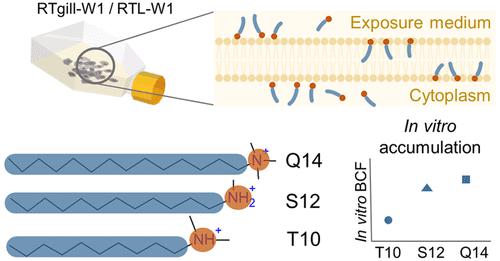当前位置:
X-MOL 学术
›
Environ. Sci. Technol.
›
论文详情
Our official English website, www.x-mol.net, welcomes your
feedback! (Note: you will need to create a separate account there.)
Bioconcentration Assessment of Three Cationic Surfactants in Permanent Fish Cell Lines
Environmental Science & Technology ( IF 10.8 ) Pub Date : 2024-01-12 , DOI: 10.1021/acs.est.3c05360
Fabian Balk 1, 2 , Bastian Hüsser 1, 3 , Juliane Hollender 1, 3 , Kristin Schirmer 1, 2, 3
Environmental Science & Technology ( IF 10.8 ) Pub Date : 2024-01-12 , DOI: 10.1021/acs.est.3c05360
Fabian Balk 1, 2 , Bastian Hüsser 1, 3 , Juliane Hollender 1, 3 , Kristin Schirmer 1, 2, 3
Affiliation

|
Cationic surfactants are used in many industrial processes and in consumer products with concurrent release into the aquatic environment, where they may accumulate in aquatic organisms to regulatoryly relevant thresholds. Here, we aimed to better understand the bioconcentration behavior of three selected cationic surfactants, namely N,N-dimethyldecylamine (T10), N-methyldodecylamine (S12), and N,N,N-trimethyltetradecylammonium cation (Q14), in the cells of fish liver (RTL-W1) and gill (RTgill-W1) cell lines. We conducted full mass balances for bioconcentration tests with the cell cultures, in which the medium, the cell surface, the cells themselves, and the plastic compartment were sampled and quantified for each surfactant by HPLC MS/MS. Accumulation in/to cells correlated with the surfactants’ alkyl chain lengths and their membrane lipid–water partitioning coefficient, DMLW. Cell-derived bioconcentration factors (BCF) of T10 and S12 were within a factor of 3.5 to in vivo BCF obtained from the literature, while the cell-derived BCF values for Q14 were >100 times higher than the in vivo BCF. From our experiments, rainbow trout cell lines appear as a suitable conservative in vitro screening method for bioconcentration assessment of cationic surfactants and are promising for further testing.
中文翻译:

三种阳离子表面活性剂在永久性鱼细胞系中的生物浓度评估
阳离子表面活性剂用于许多工业过程和消费品中,同时释放到水生环境中,它们可能在水生生物中累积至监管相关阈值。在这里,我们的目的是更好地了解三种选定的阳离子表面活性剂,即N,N-二甲基癸胺 (T10)、 N-甲基十二胺 (S12) 和N,N,N-三甲基十四烷基铵阳离子 (Q14) 在细胞中的生物浓缩行为鱼肝(RTL-W1)和鳃(RTgill-W1)细胞系。我们对细胞培养物的生物浓度测试进行了全面的质量平衡,其中对培养基、细胞表面、细胞本身和塑料隔室进行了采样,并通过 HPLC MS/MS 对每种表面活性剂进行了定量。细胞内/细胞内的积累与表面活性剂的烷基链长度及其膜脂-水分配系数D MLW相关。 T10 和 S12 的细胞衍生生物浓缩因子 (BCF) 与从文献中获得的体内BCF 相差 3.5 倍以内,而 Q14 的细胞衍生生物浓缩因子 (BCF) 值比体内BCF 高 100 倍以上。从我们的实验来看,虹鳟鱼细胞系似乎是一种适合阳离子表面活性剂生物浓度评估的保守体外筛选方法,并且有望进行进一步测试。
更新日期:2024-01-12
中文翻译:

三种阳离子表面活性剂在永久性鱼细胞系中的生物浓度评估
阳离子表面活性剂用于许多工业过程和消费品中,同时释放到水生环境中,它们可能在水生生物中累积至监管相关阈值。在这里,我们的目的是更好地了解三种选定的阳离子表面活性剂,即N,N-二甲基癸胺 (T10)、 N-甲基十二胺 (S12) 和N,N,N-三甲基十四烷基铵阳离子 (Q14) 在细胞中的生物浓缩行为鱼肝(RTL-W1)和鳃(RTgill-W1)细胞系。我们对细胞培养物的生物浓度测试进行了全面的质量平衡,其中对培养基、细胞表面、细胞本身和塑料隔室进行了采样,并通过 HPLC MS/MS 对每种表面活性剂进行了定量。细胞内/细胞内的积累与表面活性剂的烷基链长度及其膜脂-水分配系数D MLW相关。 T10 和 S12 的细胞衍生生物浓缩因子 (BCF) 与从文献中获得的体内BCF 相差 3.5 倍以内,而 Q14 的细胞衍生生物浓缩因子 (BCF) 值比体内BCF 高 100 倍以上。从我们的实验来看,虹鳟鱼细胞系似乎是一种适合阳离子表面活性剂生物浓度评估的保守体外筛选方法,并且有望进行进一步测试。































 京公网安备 11010802027423号
京公网安备 11010802027423号